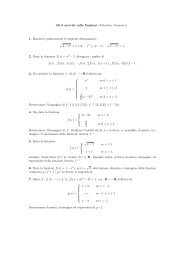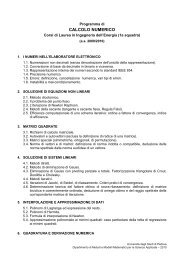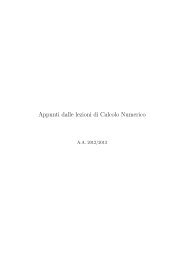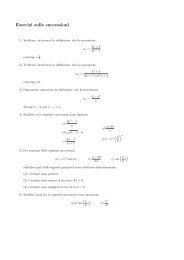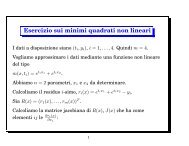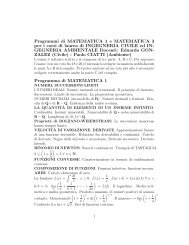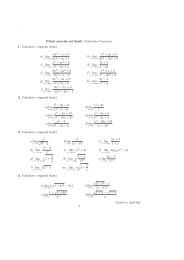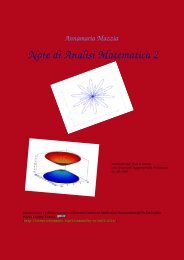Appunti di Calcolo Numerico - Esercizi e Dispense - Università degli ...
Appunti di Calcolo Numerico - Esercizi e Dispense - Università degli ...
Appunti di Calcolo Numerico - Esercizi e Dispense - Università degli ...
Create successful ePaper yourself
Turn your PDF publications into a flip-book with our unique Google optimized e-Paper software.
11.8. Errori <strong>di</strong> troncamento locale<br />
Gli errori <strong>di</strong> arrotondamento nell’approssimare la derivata prima <strong>di</strong> una funzione si comportano come<br />
O ( 1 ) (si veda l’esempio fatto sulla propagazione <strong>degli</strong> errori a pag. 30). Tuttavia questo aspetto <strong>di</strong>venta secondario<br />
nella risoluzione delle ODE sia perchè il passo h nelle applicazioni non è mai troppo (esagerata-<br />
h<br />
mente) piccolo per ragioni <strong>di</strong> efficienza sia perchè è la y e non la y ′ la funzione che dobbiamo approssimare.<br />
Inoltre, nell’eseguire i calcoli in doppia precisione (come si fa nei moderni linguaggi <strong>di</strong> programmazione),<br />
l’aspetto dovuto all’arrotondamento si vede poco rispetto ad altri fenomeni che influenzano la propagazione<br />
<strong>degli</strong> errori.<br />
11.8 Errori <strong>di</strong> troncamento locale<br />
G Nel metodo <strong>di</strong> Eulero esplicito:<br />
G Nel metodo <strong>di</strong> Eulero implicito:<br />
d i = y(t i+1) − y(t i )<br />
− f (t i , y(t i )) = h h<br />
2 y′′ (ξ i ) = O (h)<br />
d i = y(t i+1) − y(t i )<br />
− f (t i , y(t i+1 )) = − h h<br />
2 y′′ (ξ i ) = O (h)<br />
G Nel metodo <strong>di</strong> Crank-Nicolson (derivando la formula dai trapezi e includendo il termine dell’errore):<br />
y(t i+1 ) − y(t i ) = h 2 [f (t i , y(t i )) + f (t i+1 , y(t i+1 ))] − f ′′ (ξ i ,τ i )<br />
h 3<br />
12<br />
dove ξ i e τ i sono opportuni punti. Ma f = y ′ da cui f ′ = y ′′ e f ′′ = y ′′′ .<br />
Perciò<br />
y(t i+1 ) − y(t i ) = h 2 [f (t i , y(t i )) + f (t i+1 , y(t i+1 ))] − y′′′ (ξ i )<br />
h 3<br />
12<br />
d i = y(t i+1) − y(t i )<br />
h<br />
11.9 Convergenza e stabilità<br />
Definizione 11.9.1 Un metodo si <strong>di</strong>ce convergente se lim h→0<br />
− 1 2 [f (t i , y(t i )) + f (t i+1 , y(t i+1 ))] = − y′′′ (ξ i )<br />
h 2 = O (h 2 )<br />
12<br />
i→+∞<br />
ɛ i = 0 cioè se l’errore va a zero al tendere del<br />
passo h a zero e <strong>di</strong> i all’infinito in modo che il prodotto i h si mantenga costante (così t 0 +i h tende ad un valore<br />
<strong>di</strong> t fissato: stu<strong>di</strong>amo l’errore fissato t).<br />
Esempio<br />
Esempio 11.9.1 Ve<strong>di</strong>amo come, fissato un certo istante t, possiamo fare tendere h a zero e far crescere i<br />
all’infinito in modo che t 0 + i h sia sempre uguale a t. Sia t 0 = 0 e t = 0.5:<br />
h i i h<br />
0.5 1 0.5<br />
0.25 2 0.5<br />
0.125 4 0.5<br />
0.0625 8 0.5<br />
.<br />
.<br />
.<br />
2.4414e-4 2048 0.5<br />
Definizione 11.9.2 Un metodo si <strong>di</strong>ce stabile se l’errore iniziale si mantiene limitato al crescere <strong>di</strong> i (per i → ∞):<br />
con M costante positiva.<br />
|ɛ i | ≤ M|ɛ 0 |<br />
177



